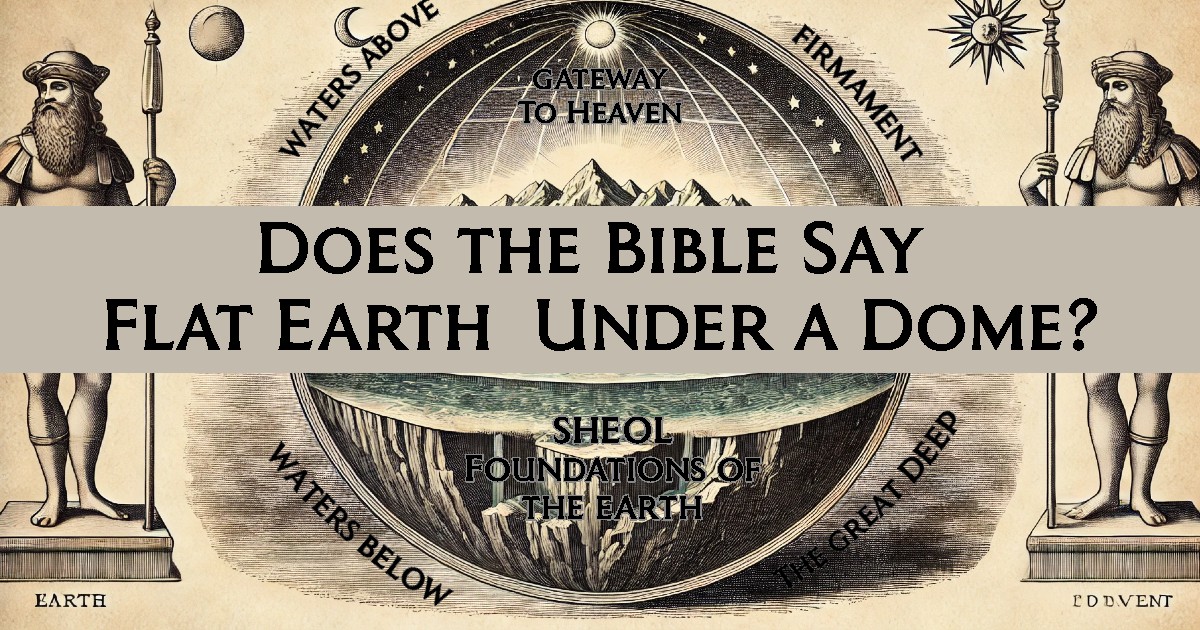For centuries, debates have raged over the Bible’s descriptions of the cosmos. While modern science tells us we live on a spherical planet orbiting the sun in an ever-expanding universe, the Bible appears to describe a vastly different reality—one where the Earth is flat, immovable, and covered by a solid dome called the firmament. But does the Bible really support this ancient cosmology? And if so, what does that mean for believers today?
Biblical Evidence for a Flat Earth Under a Dome
The Firmament: A Solid Dome Over the Earth
The most compelling biblical reference to a dome-like structure over the Earth is found in Genesis 1:6-8:
“And God said, ‘Let there be a firmament in the midst of the waters, and let it divide the waters from the waters.’”
The Hebrew word for firmament, raqia, means a solid expanse or vault. Ancient Hebrew cosmology, like that of other Near Eastern cultures, depicted the sky as a hard dome holding back celestial waters. Stars were thought to be embedded in this dome, and windows could open to allow rain to fall (Genesis 7:11).
The Earth Is Described as Flat and Immovable
Throughout the Bible, the Earth is repeatedly described as being set on foundations, implying a fixed, unmoving plane:
- Psalm 104:5 – “He set the earth on its foundations; it can never be moved.”
- 1 Chronicles 16:30 – “The world is firmly established; it cannot be moved.”
There is no mention of a rotating, orbiting sphere. Instead, the language suggests an Earth that is stationary, as believed by ancient civilizations.
The “Ends of the Earth” and the Four Corners
The Bible frequently refers to the Earth having ends and corners, which contradicts a spherical Earth:
- Isaiah 11:12 – “He will assemble the scattered people of Judah from the four corners of the earth.”
- Job 38:13 – “That it might take the earth by the edges and shake the wicked out of it.”
A sphere has no corners or edges, yet biblical descriptions consistently imply a flat, defined surface.
The Sun and Moon Move, Not the Earth
In the Bible, celestial bodies move around the Earth, rather than the Earth moving around the sun:
- Joshua 10:12-13 – Joshua commands the sun and moon to stand still, which only makes sense in a geocentric, flat-Earth model.
- Ecclesiastes 1:5 – “The sun rises and the sun sets, and hurries back to where it rises.”
This description is inconsistent with heliocentrism, which would instead describe the Earth’s rotation causing the illusion of sunrise and sunset.
Contradiction with Modern Science
Every piece of scientific evidence we have—satellite imagery, physics, and astronomy—confirms the Earth is an oblate spheroid, not a flat disc beneath a dome. The Bible’s descriptions align with ancient cultural beliefs, not reality as we understand it today.
So what does this mean for believers? If biblical cosmology was simply the ancient understanding of the world at the time, can we selectively accept some parts of the Bible while rejecting others? And if the Bible was mistaken about the structure of the Earth, what else might it have been mistaken about?
A Challenge to Belief
If you believe the Bible is the infallible word of God, then why does it describe a universe that doesn’t exist? And if these descriptions are metaphorical, how do we determine which parts of the Bible are literal and which are symbolic?
This is more than just a scientific question—it’s a theological dilemma. If biblical cosmology is outdated and incorrect, what does that say about the divine inspiration of the text?
Is faith strong enough to accept that the Bible’s worldview might be flawed, or must believers reject science to uphold scripture?
Books on the Bible’s Flat Earth Model & Ancient Cosmology
- Paul H. Seely (1991). The Firmament and the Water Above: The Meaning of Rāqîaʿ in Genesis 1:6-8
- Peter Enns (2012). The Evolution of Adam: What the Bible Does and Doesn’t Say about Human Origins
- John H. Walton (2009). The Lost World of Genesis One: Ancient Cosmology and the Origins Debate
- Michael S. Heiser (2015). The Unseen Realm: Recovering the Supernatural Worldview of the Bible
- Russell E. Gmirkin (2006). Berossus and Genesis, Manetho and Exodus: Hellenistic Histories and the Date of the Pentateuch
- Lita Cosner & Robert Carter (2021). Did Moses Write Genesis?
- Phil Senter (2011). The Genesis Cosmology as a Background for Noah’s Flood
- Jeffrey Rogers (2018). The Scriptures and Ancient Science: Examining the Cosmology of the Bible
- Edward Gleason (1890). Is the Bible from Heaven? Is the Earth a Globe?
- Joseph M. Holden & Norman L. Geisler (2013). The Popular Handbook of Archaeology and the Bible

